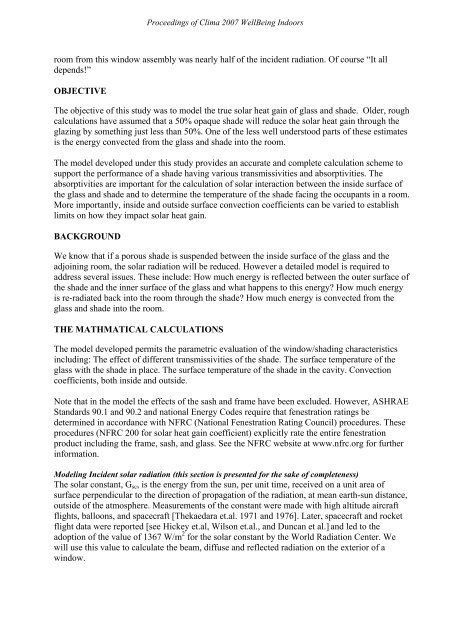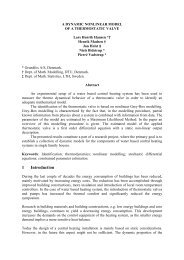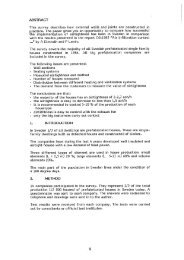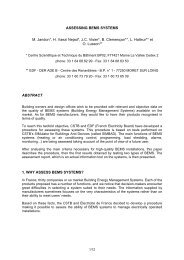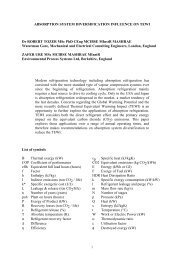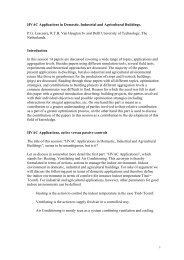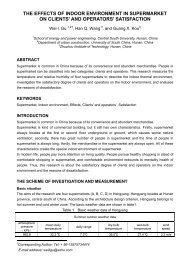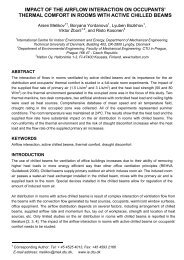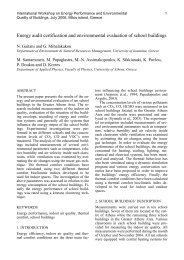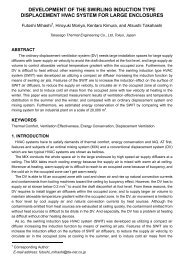Modeling the Heat Gain of a Window With an Interior Shade ... - inive
Modeling the Heat Gain of a Window With an Interior Shade ... - inive
Modeling the Heat Gain of a Window With an Interior Shade ... - inive
Create successful ePaper yourself
Turn your PDF publications into a flip-book with our unique Google optimized e-Paper software.
Proceedings <strong>of</strong> Clima 2007 WellBeing Indoors<br />
room from this window assembly was nearly half <strong>of</strong> <strong>the</strong> incident radiation. Of course “It all<br />
depends!”<br />
OBJECTIVE<br />
The objective <strong>of</strong> this study was to model <strong>the</strong> true solar heat gain <strong>of</strong> glass <strong>an</strong>d shade. Older, rough<br />
calculations have assumed that a 50% opaque shade will reduce <strong>the</strong> solar heat gain through <strong>the</strong><br />
glazing by something just less th<strong>an</strong> 50%. One <strong>of</strong> <strong>the</strong> less well understood parts <strong>of</strong> <strong>the</strong>se estimates<br />
is <strong>the</strong> energy convected from <strong>the</strong> glass <strong>an</strong>d shade into <strong>the</strong> room.<br />
The model developed under this study provides <strong>an</strong> accurate <strong>an</strong>d complete calculation scheme to<br />
support <strong>the</strong> perform<strong>an</strong>ce <strong>of</strong> a shade having various tr<strong>an</strong>smissivities <strong>an</strong>d absorptivities. The<br />
absorptivities are import<strong>an</strong>t for <strong>the</strong> calculation <strong>of</strong> solar interaction between <strong>the</strong> inside surface <strong>of</strong><br />
<strong>the</strong> glass <strong>an</strong>d shade <strong>an</strong>d to determine <strong>the</strong> temperature <strong>of</strong> <strong>the</strong> shade facing <strong>the</strong> occup<strong>an</strong>ts in a room.<br />
More import<strong>an</strong>tly, inside <strong>an</strong>d outside surface convection coefficients c<strong>an</strong> be varied to establish<br />
limits on how <strong>the</strong>y impact solar heat gain.<br />
BACKGROUND<br />
We know that if a porous shade is suspended between <strong>the</strong> inside surface <strong>of</strong> <strong>the</strong> glass <strong>an</strong>d <strong>the</strong><br />
adjoining room, <strong>the</strong> solar radiation will be reduced. However a detailed model is required to<br />
address several issues. These include: How much energy is reflected between <strong>the</strong> outer surface <strong>of</strong><br />
<strong>the</strong> shade <strong>an</strong>d <strong>the</strong> inner surface <strong>of</strong> <strong>the</strong> glass <strong>an</strong>d what happens to this energy? How much energy<br />
is re-radiated back into <strong>the</strong> room through <strong>the</strong> shade? How much energy is convected from <strong>the</strong><br />
glass <strong>an</strong>d shade into <strong>the</strong> room.<br />
THE MATHMATICAL CALCULATIONS<br />
The model developed permits <strong>the</strong> parametric evaluation <strong>of</strong> <strong>the</strong> window/shading characteristics<br />
including: The effect <strong>of</strong> different tr<strong>an</strong>smissivities <strong>of</strong> <strong>the</strong> shade. The surface temperature <strong>of</strong> <strong>the</strong><br />
glass with <strong>the</strong> shade in place. The surface temperature <strong>of</strong> <strong>the</strong> shade in <strong>the</strong> cavity. Convection<br />
coefficients, both inside <strong>an</strong>d outside.<br />
Note that in <strong>the</strong> model <strong>the</strong> effects <strong>of</strong> <strong>the</strong> sash <strong>an</strong>d frame have been excluded. However, ASHRAE<br />
St<strong>an</strong>dards 90.1 <strong>an</strong>d 90.2 <strong>an</strong>d national Energy Codes require that fenestration ratings be<br />
determined in accord<strong>an</strong>ce with NFRC (National Fenestration Rating Council) procedures. These<br />
procedures (NFRC 200 for solar heat gain coefficient) explicitly rate <strong>the</strong> entire fenestration<br />
product including <strong>the</strong> frame, sash, <strong>an</strong>d glass. See <strong>the</strong> NFRC website at www.nfrc.org for fur<strong>the</strong>r<br />
information.<br />
<strong>Modeling</strong> Incident solar radiation (this section is presented for <strong>the</strong> sake <strong>of</strong> completeness)<br />
The solar const<strong>an</strong>t, G sc , is <strong>the</strong> energy from <strong>the</strong> sun, per unit time, received on a unit area <strong>of</strong><br />
surface perpendicular to <strong>the</strong> direction <strong>of</strong> propagation <strong>of</strong> <strong>the</strong> radiation, at me<strong>an</strong> earth-sun dist<strong>an</strong>ce,<br />
outside <strong>of</strong> <strong>the</strong> atmosphere. Measurements <strong>of</strong> <strong>the</strong> const<strong>an</strong>t were made with high altitude aircraft<br />
flights, balloons, <strong>an</strong>d spacecraft [Thekaedara et.al. 1971 <strong>an</strong>d 1976]. Later, spacecraft <strong>an</strong>d rocket<br />
flight data were reported [see Hickey et.al, Wilson et.al., <strong>an</strong>d Dunc<strong>an</strong> et al.] <strong>an</strong>d led to <strong>the</strong><br />
adoption <strong>of</strong> <strong>the</strong> value <strong>of</strong> 1367 W/m 2 for <strong>the</strong> solar const<strong>an</strong>t by <strong>the</strong> World Radiation Center. We<br />
will use this value to calculate <strong>the</strong> beam, diffuse <strong>an</strong>d reflected radiation on <strong>the</strong> exterior <strong>of</strong> a<br />
window.


